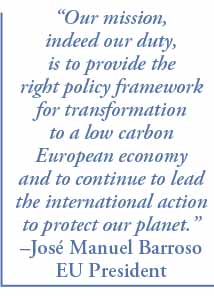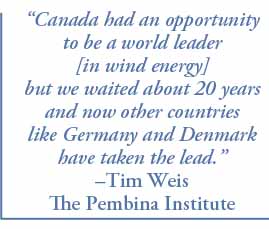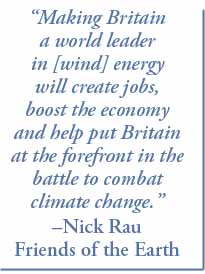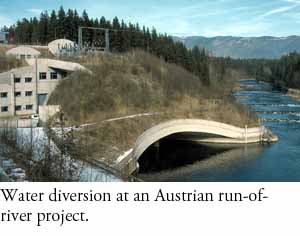
With an arguably greater sense of environmental awareness and a stronger economic motive for conservation, Europeans pioneered green energy initiatives long before they were even discussed in B.C.
 Higher energy prices provided a practical incentive. But many Europeans also saw something precious being lost as acid rain destroyed the crowded continent’s lakes and forests.
Higher energy prices provided a practical incentive. But many Europeans also saw something precious being lost as acid rain destroyed the crowded continent’s lakes and forests.
Most European countries took the Kyoto Accord to heart and agreed to significant CO2 cuts set by the European Union. In 2001 the EU mandated an increase in renewable electricity to 22 per cent overall by 2010, with each country setting a different goal to help meet the continent-wide target. Austria’s commitment, for example, will ensure that 78 per cent of its electricity consumption is green.
Last year the EU set further goals for 2020: a 20-per-cent cut in GHGs overall, a 20-per-cent increase in energy efficiency and a 20-per-cent increase in renewables for all energy consumption, not just electricity.
European countries differ greatly in their energy sources. Nuclear power accounts for nearly 80 per cent of France’s electricity but is banned outright in Austria. Fossil-fuelled thermal generation still creates much of Europe’s electricity, but clean, green sources are expanding quickly. The pristine Alps are home to literally thousands of run-of-river hydro projects. And wind power is the continent’s — and the world’s — fastest-growing source of renewable energy.
 A world leader in wind energy, Denmark offers a longstanding model of environmental awareness. In fact the Danish government is said to be the world’s first to include a climate minister.
A world leader in wind energy, Denmark offers a longstanding model of environmental awareness. In fact the Danish government is said to be the world’s first to include a climate minister.
Around 23 per cent of the country’s electricity comes from wind. By 2025 the country plans to increase that number to 50 per cent, much of it from offshore wind farms. In fact two of the world’s largest wind farms are located in Danish waters: the Horns Rev Offshore Wind Farm, 14 to 20 kilometres off the North Sea coast, and the Nysted Offshore Wind Farm, about 10 kilometres off the Baltic coast. Together they generate enough electricity for about 300,000 Danish homes.
With eight offshore farms built since 1991, Danes have had plenty of time to monitor the environmental effects. Along with the Danish Energy Authority, the country’s independent operators have used that time wisely, conducting extensive environmental studies. Denmark has made it that much easier for others to follow their example in creating renewable, sustainable energy.
 In a dramatic announcement prior to the 2007 UN Climate Conference in Bali, the UK government called on independent companies to boost Britain’s future wind power capacity over 300 per cent by 2020. The program will help the country achieve self-sufficiency while providing enough wind-generated electricity for every home in the country.
In a dramatic announcement prior to the 2007 UN Climate Conference in Bali, the UK government called on independent companies to boost Britain’s future wind power capacity over 300 per cent by 2020. The program will help the country achieve self-sufficiency while providing enough wind-generated electricity for every home in the country.
As a result, Britain is about to lead the world in wind energy. Most of it will come from offshore wind farms.
Independents have been developing wind power off Britain’s coasts since 2001 and have earned a reputation for their expertise and environmental awareness. Already, almost half the world’s wind farm construction takes place in Britain. Among the projects under construction is the London Array, 12 miles off the coast of Kent and Essex. When complete this will be the world’s largest offshore wind farm.
Britain’s wind expansion starts with an extensive study called the Strategic Environmental Assessment. The plan has wide-ranging support from opposition parties and environmental groups.
 With a geography not unlike B.C., Switzerland is a pioneer of run-of-river hydro. Almost every stream and river in the Alps generates run-of-river power, which now supplies over a quarter of the country’s electricity. More than 900 companies are involved, offering electrical production and distribution. Switzerland is a net exporter of electricity.
With a geography not unlike B.C., Switzerland is a pioneer of run-of-river hydro. Almost every stream and river in the Alps generates run-of-river power, which now supplies over a quarter of the country’s electricity. More than 900 companies are involved, offering electrical production and distribution. Switzerland is a net exporter of electricity.
Switzerland’s drive for renewable energy goes back at least to the 1980s, following public concern about nuclear power. Then, following the Kyoto Protocol, the country legislated CO2-reduction targets. As a result, Swiss power generation is now 97 per cent carbon-free.
Not stopping there, the federal government is considering a proposal to increase its proportion of renewable electricity from 67 per cent to 77 per cent by 2030.
 Although wind power accounts for little of Austria’s electricity, over two-thirds comes from hydro – and, for the most part, small hydro.
Although wind power accounts for little of Austria’s electricity, over two-thirds comes from hydro – and, for the most part, small hydro.
Austria’s pledge to increase its supply of renewable electricity to 78 per cent by 2010 will keep the country well above the European Union average of 22 per cent. That impressive commitment has spurred many more small hydro projects, with an emphasis on run of river. Well over 1,200 such projects transmit power to the national grid. Amazingly, upwards of 5,000 other micro-hydro projects aren’t even connected to the grid. Over 40 companies generate electricity, while the country has 125 electricity retailers.
Seemingly imprisoned by its abundance of greenhouse gas-emitting resources, Alberta might be considered Canada’s environmental villain. But it’s a major source of B.C.’s electricity.
Coal-fired electricity – among the world’s worst producers of GHGs – supplies half of Alberta’s electricity needs. Natural gas, another local GHG-rich resource, supplies an additional 40 per cent. The rest comes from a combination of hydro and wind, with some biomass.
Although the B.C. Energy Plan calls for future self-sufficiency, we currently import our neighbour’s dirty power. Yet B.C.’s energy resources are almost boundlessly green. Alberta’s, on the other hand, could be considered a mixed blessing.
During 2000 and 2001 electricity prices skyrocketed as people poured into the oil-rich province, pushing demand far beyond supply. At the same time, natural gas prices hit unprecedented levels, with unprecedented effects on electricity prices. Rates eventually dropped as companies created an oversupply through Canada’s largest-ever investment in electricity generation.
The investment mostly went to dirty power.
And it continues. One company plans to spend up to $1.5 billion by 2020 to lighten the GHG emissions from its coal-fired plants. The cost will be borne by consumers but, despite greenwashing to the contrary, no technology exists to effectively reduce coal plant CO2s. Another company plans to build a huge, 1,200 megawatt natural gas- and gas-from-coal-generating plant, which will pump out further emissions.
In addition, two nuclear reactors are proposed for the Peace River region, just 100 kilometres east of the B.C. border. If approved, around 70 per cent of their power will be used to replace a dwindling supply of natural gas that’s used for heavy oil extraction.
Yet for all that, even Alberta leads B.C. in wind energy. In fact Alberta once led the country in wind generation but lost its lead due to – guess what? – its reliance on coal.
Coal-fired electricity, unlike hydro, suffers from slow ramp-up and ramp-down times. Fluctuations in wind energy rely on another source of electricity to quickly pick up the slack. Hydro works, coal doesn’t.
For that reason, Alberta’s regulatory board has imposed a near-moratorium on new wind power development. Currently about four per cent of the province’s demand is met by wind, although even under the new restrictions the province’s wind supply could rise to around 10 per cent. Alberta also has enormous run-of-river hydro potential in the north.
But the province seems fixated on its own dirty power sources – coal- and natural gas-fired electricity. This is the stuff that B.C. imports.
SaskPower, a provincial Crown corporation with a near-monopoly, generates most of the province’s electricity from coal and gas — among the world’s worst sources of GHGs. The utility plans to expand gas generation this year, coal generation by 2011 or 2012 and possibly add a nuclear plant by 2018.
Coal-fired electricity provides around 70 per cent of Saskatchewan’s needs. Big hydro supplies around 20 per cent more and gas-fired plants another five per cent.
Two small wind farms popped up in 2002 but it wasn’t until 2006 that wind power really blew some fresh air into Saskatchewan’s energy production. That year the Centennial Wind Power Facility opened near Swift Current. For a while, it was Canada’s largest. Designed to supply about 64,000 homes annually, it reached the equivalent of about 69,000 in its first year.
Wind now provides five per cent of Saskatchewan’s electricity needs, one of the highest rates in Canada. But with its plans for more coal and a possible nuclear plant, SaskPower seems committed to non-renewable, dirty energy sources.
There’s another interesting contrast with B.C. While the SaskPower union, the International Brotherhood of Electrical Workers (IBEW) Local 2067, supports dirty energy, the province’s environmentalists oppose it. B.C.’s self-proclaimed environmentalists, on the other hand, work very closely with the B.C. Hydro union, COPE 378, despite its campaign for gas-fired electricity.
Manitoba’s first wind farm has proven so successful that the province plans to quadruple its wind-generated supply. In response, some 17 independent producers have offered 83 proposals to build new wind farms.
They’re following in the footsteps of Algonquin Power, an independent that sells energy to Manitoba Hydro from its facility near St. Leon, in an agricultural district 150 kilometres southwest of Winnipeg. The project’s 63 turbines generate enough clean power for over 35,000 homes a year. They’ve also turned St. Leon into a tourist magnet, creating another economic spinoff from green energy.
Manitoba’s NDP government has campaigned strongly on its wind energy policy, in which the province’s Crown utility buys clean electricity from independent power producers. Last November Manitoba Hydro announced an agreement to buy electricity from the province’s second wind farm, to be built by an independent partnership near St. Joseph, about 80 kilometres south of Winnipeg. Planned for completion in 2011, it will create enough energy for well over 100,000 homes, making St. Joseph the largest wind project in Canada. It will displace about 800,000 tonnes of GHGs a year, the equivalent of taking 145,000 cars off the road.
Click here to see a short film with local residents discussing the St. Leon wind farm.
Early indications suggest that Ontario’s Green Energy Act, announced in February 2009, marks a decisive commitment to sustainable electricity. The plan calls for more conservation, more sources of renewable energy, greater transmission capacity to carry it, incentives for home-generated power and a revitalized manufacturing sector to build the infrastructure. The result, say proponents, will be 50,000 new green collar jobs.
Up to now big hydro and nuclear power have provided most of the province’s electricity. Recent years have seen a renewed interest in gas-fired electricity, a serious source of GHGs. But now the province is also turning to renewables like small hydro, biomass, solar and especially wind.
In the latter field, Ontario leads the country. The province has several wind projects in operation or under review, with B.C. companies participating. Last October the Melancthon EcoPower Centre, about 100 kilometres northwest of Toronto, overtook another project near Sault Ste. Marie to become the country’s largest wind farm. Melancthon will supply the equivalent of about 70,000 homes, over 10 per cent of Canada’s total wind energy output.
Surprisingly, since its sunlight stats are unimpressive even by B.C. standards, Ontario also leads the country in solar electricity. Work has begun on projects in Sarnia, Sault Ste. Marie and Stone Mills, about 30 kilometres west of Kingston. These three locations will create enough electricity for approximately 14,000 Ontario homes by about 2010. Several more projects are currently being proposed or are under development.
The Green Energy Act notwithstanding, a nuclear spectre continues to loom over Ontarians. Sixteen Ontario nuclear plants provide about half of the province’s electricity. Some are being refurbished to extend their working lives and at least two additional reactors are being proposed. Ontario plans to become coal-free by 2014, which will cut greenhouse gases by the equivalent of 2.3 million cars a year. But the plan relies largely on nuclear energy.